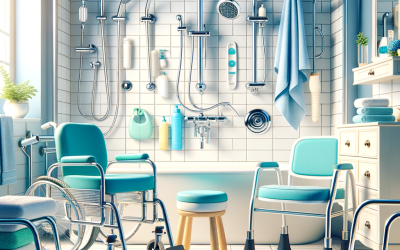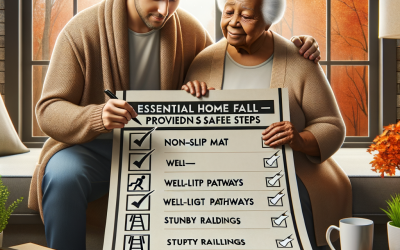The kitchen is the heart of the home—it’s where we gather, cook, and create memories. But as we age, it can also become one of the most hazardous areas in the house. From slippery floors to hard-to-reach cabinets, a poorly designed kitchen can lead to accidents and frustration. The good news? With a few simple adjustments, you can make your kitchen safer, more accessible, and easier to navigate—without sacrificing style or functionality.
Whether you’re updating your own kitchen or helping a loved one, here are some practical ways to create a senior-friendly kitchen that promotes independence and peace of mind.
1. Improve Lighting for Better Visibility
As we get older, our eyesight changes, making it harder to see small details, especially in dim lighting. Proper lighting is essential for preventing kitchen accidents.
✅ Upgrade Overhead Lighting: Swap out dim bulbs for bright LED lights that mimic natural daylight.
✅ Under-Cabinet Lighting: Adds extra brightness to countertops, making food prep easier and safer.
✅ Motion-Sensor Night Lights: Perfect for late-night trips to the kitchen, preventing falls.
💡 Sarah’s Tip: My mom struggled with nighttime visibility, so we installed stick-on LED motion lights along her cabinets—now, she never has to fumble for a light switch at 2 AM!
2. Make Floors Slip-Proof
Slippery floors are one of the biggest fall hazards in a kitchen, especially if spills go unnoticed.
✅ Use Non-Slip Mats or Rugs: Place rubber-backed mats in high-risk areas like near the sink and stove.
✅ Avoid Glossy Tile or Polished Wood: If remodeling, opt for textured, slip-resistant flooring such as vinyl or cork.
✅ Clean Up Spills Immediately: Keep a microfiber mop handy to wipe up water or oil quickly.
💡 Sarah’s Tip: We replaced my mother-in-law’s slippery rug with a memory foam anti-fatigue mat—it’s soft, supportive, and won’t slide around.
3. Keep Essentials Within Easy Reach
Reaching for items on high shelves or low cabinets can lead to falls and strains. Organizing the kitchen so that everything is within arm’s reach can make a big difference.
✅ Store Everyday Items at Waist Level: Plates, cups, and cooking essentials should be easily accessible.
✅ Use Pull-Out Shelves or Lazy Susans: Helps seniors reach into deep cabinets without bending or straining.
✅ Ditch Heavy Cookware: Opt for lightweight pots and pans with easy-grip handles.
💡 Sarah’s Tip: My aunt switched to nonstick aluminum cookware with silicone handles, and she loves how easy they are to lift and clean!
4. Choose Easy-to-Use Kitchen Tools and Appliances
Some kitchen gadgets can be tough to use if you have arthritis, limited grip strength, or reduced dexterity. Swapping to senior-friendly kitchen tools makes cooking easier and more enjoyable.
✅ Electric Can Opener: No more struggling with manual can openers!
✅ One-Touch Jar Opener: A lifesaver for opening stubborn lids.
✅ Ergonomic Utensils: Look for oversized, easy-grip handles on knives, peelers, and spatulas.
✅ Induction Cooktop: These stovetops only heat the pan, reducing burn risks.
💡 Sarah’s Tip: My mom swears by her automatic jar opener—it makes opening pickle jars a breeze!
5. Upgrade Stove and Oven Safety
Cooking-related accidents—like burns, fires, and forgotten stovetops—are common among seniors. A few safety upgrades can lower the risk while maintaining independence.
✅ Auto Shut-Off Stove or Cooktop: Many modern stoves turn off automatically after a period of inactivity.
✅ Use Back Burners First: This prevents clothing or sleeves from catching on fire.
✅ Induction Cooktop: Safer than gas or electric, as it only heats when a pan is on the burner.
✅ Stove Knob Covers or Safety Locks: Prevent accidental bumps that turn the stove on.
💡 Sarah’s Tip: If replacing a stove isn’t an option, plug-in induction burners are a great alternative for safer stovetop cooking!
6. Make the Sink More Accessible
Standing at the sink for long periods can be tiring for seniors, and faucets with small knobs may be hard to turn. A few simple fixes can make washing dishes easier and safer.
✅ Install a Pull-Down Faucet: Easier to use than traditional taps, especially for those with arthritis.
✅ Add a Stool or Perch Seat: Reduces strain for those who prefer to sit while washing dishes.
✅ Use a Shallow Sink Basin: Easier to reach into than deep sinks.
💡 Sarah’s Tip: A touchless kitchen faucet is a fantastic upgrade—it allows seniors to turn the water on and off with a wave of the hand!
7. Ensure Fire and Electrical Safety
A safe kitchen isn’t just about convenience—it’s also about fire prevention and electrical safety.
✅ Keep a Fire Extinguisher Nearby: Ensure it’s easy to reach and use.
✅ Check Smoke & Carbon Monoxide Detectors: Test them monthly and change batteries regularly.
✅ Unplug Small Appliances When Not in Use: Reduces electrical fire risks.
✅ Avoid Long Cords or Cluttered Outlets: Use cord organizers to prevent tripping hazards.
💡 Sarah’s Tip: We added a stovetop fire suppression system in my mom’s kitchen—if flames get too high, the system automatically deploys to stop the fire!
Final Thoughts
A well-organized, senior-friendly kitchen makes meal prep safer, easier, and more enjoyable. Whether it’s better lighting, slip-proof flooring, or smart appliances, these changes help seniors maintain their independence and confidence in the kitchen.
Are there any kitchen modifications that have worked well for you or a loved one? Share your tips in the comments—we’d love to hear them!




0 Comments